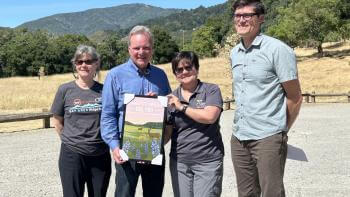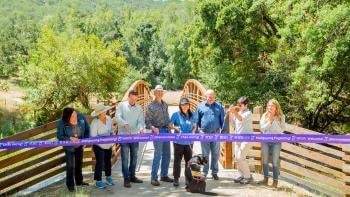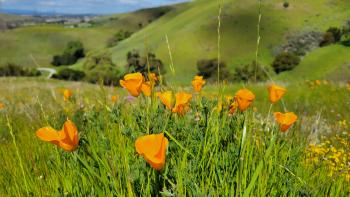Pond Habitat Restoration
Tucked away among the rolling golden hills of Rancho Cañada del Oro Space Preserve lie three cattle ponds that now also serve as critical habitats for native, aquatic species.
The two small ponds and one large pond, which are situated along the eastern foothills of the Santa Cruz Mountains, were originally built by a local rancher to provide water for grazing cattle. Today, the land is owned and managed by the Santa Clara Valley Open Space Authority and is part of the agency’s vision for the future expansion of Rancho Cañada del Oro Open Space Preserve. The two smaller ponds dry up in early summer and the larger pond maintains water year-round. While the original intended use of the ponds was for cattle, native and sensitive species like the California red-legged frog, the California tiger salamander, newts and the western pond turtle have taken refuge there.
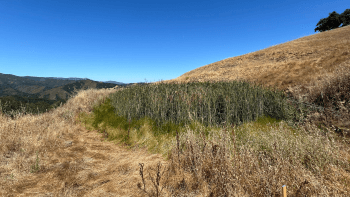
In the larger pond, invasive catfish became the predominant species, creating an unwelcoming environment for native species. This issue, combined with erosion of all pond structures, prompted the Open Space Authority to study conditions more closely and seek funding to restore the ponds to support sensitive species and their offspring. Thanks to grants received through Valley Water's Safe, Clean Water and Natural Flood Protection Standard Grants Program and Point Blue Conservation Science, the restoration work began during the summer of 2025 and was led by Rachel Clemons, the Open Space Authority’s Watershed Restoration Specialist.
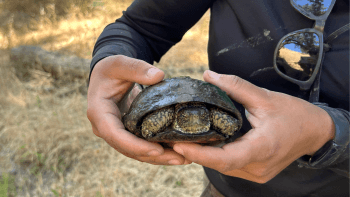
Restoration of these ponds is important because stock ponds like these have become some of the last remaining habitat for sensitive aquatic species like [California red-legged] frogs and [Northwestern pond] turtles. Historically, [these species] would have been very populous in the valley, but because we’ve developed a lot of our valley floor habitat for agriculture and businesses and homes, spaces like these in the foothills are some of the last remaining habitats, even though they’re artificial.
Because they’re man-made, the ponds require restoration as well as ongoing maintenance to make certain that native species are able to thrive.
At the start of the restoration project, it was essential for the team to address the ponds’ structural issues. The two smaller ponds were excavated to deepen them, reshaping their geometry. As a result, the water will remain in the ponds for a longer period of time, extending the wet season and providing a more stable environment for native species during the dry months.
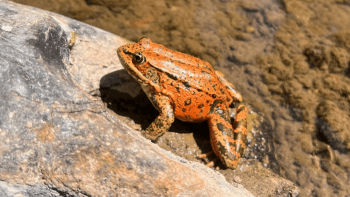
At one of the smaller ponds, a berm that borders the pond — a raised mound of earth that helps hold water in, much like a miniature dam — was eroding, threatening the habitat of the California red-legged frog which is protected by the Endangered Species Act. In the larger pond, Rachel focused her efforts on reducing populations of invasive species and leakage of pond water through the existing berm. Prior to construction, a team, including Rachel, relocated native species into Upper Llagas Creek to protect them during the pond restoration process.
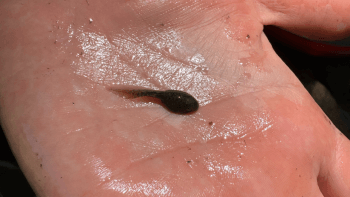
The relocation process also gave the team a rare chance to get a close look at what's been living in the ponds. The results were pretty incredible: three adult and 41 tadpole California red-legged frogs, seven western pond turtles, five adult and 417 tadpole California newts, and 318 Pacific tree frog tadpoles. Once the restoration is finished, Rachel hopes these species—or their future offspring—will find their way back home.
We’re not totally sure how long it will take the turtles or frogs to return. It’s possible that the exact individuals who relocated may not return to these ponds. It may be their offspring, grandchildren or great-grandchildren, but they found their way to these ponds in the first place, so hopefully relocating them in a safe place will support the population overall.
Post-construction, native wetland plant seeds, including narrow-leaf milkweed and California poppies, will be sown near the ponds to replace vegetation lost during the restoration process and create habitat for wildlife. To further support regrowth, additional native wetland plants (in containers) will be transplanted to boost the existing greenery.
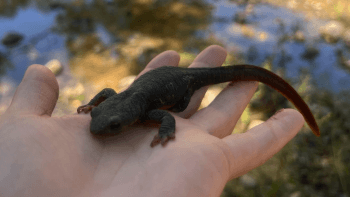
To protect these delicate habitats, the Open Space Authority worked with students from the Student Conservation Association to install cattle fencing around each pond, preventing cattle from accidentally disturbing the plants and resident species. Once the plants are established, the Open Space Authority will coordinate with a local rancher to evaluate when to let cattle back onto the project premises to reduce plant overgrowth within the ponds. This technique of intentional cattle grazing, called conservation grazing, helps the ponds maintain their ecosystem functions. Over the next few years, additional monitoring will take place to gather information and track how well the habitat is recovering.
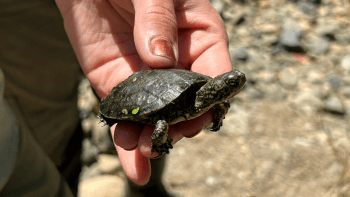
Pond monitoring will take place three times a year, giving the Open Space Authority a clearer picture of how many critters are returning to the ponds as well as the general conditions of the ponds. Findings will help the team fine-tune their methods to meet the project's restoration goals within a five-year timeline.
Through this restoration effort, the Open Space Authority is protecting vulnerable populations and helping native species thrive in their habitats for many generations to come. Get involved in the Open Space Authority's ongoing restoration efforts by becoming a volunteer!
